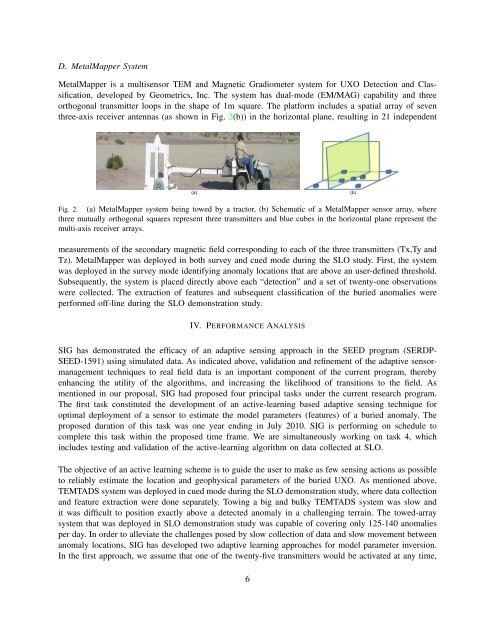INTERIM REPORT - Strategic Environmental Research and ...
INTERIM REPORT - Strategic Environmental Research and ...
INTERIM REPORT - Strategic Environmental Research and ...
You also want an ePaper? Increase the reach of your titles
YUMPU automatically turns print PDFs into web optimized ePapers that Google loves.
D. MetalMapper System<br />
MetalMapper is a multisensor TEM <strong>and</strong> Magnetic Gradiometer system for UXO Detection <strong>and</strong> Classification,<br />
developed by Geometrics, Inc. The system has dual-mode (EM/MAG) capability <strong>and</strong> three<br />
orthogonal transmitter loops in the shape of 1m square. The platform includes a spatial array of seven<br />
three-axis receiver antennas (as shown in Fig. 2(b)) in the horizontal plane, resulting in 21 independent<br />
(a)<br />
(b)<br />
Fig. 2. (a) MetalMapper system being towed by a tractor, (b) Schematic of a MetalMapper sensor array, where<br />
three mutually orthogonal squares represent three transmitters <strong>and</strong> blue cubes in the horizontal plane represent the<br />
multi-axis receiver arrays.<br />
measurements of the secondary magnetic field corresponding to each of the three transmitters (Tx,Ty <strong>and</strong><br />
Tz). MetalMapper was deployed in both survey <strong>and</strong> cued mode during the SLO study. First, the system<br />
was deployed in the survey mode identifying anomaly locations that are above an user-defined threshold.<br />
Subsequently, the system is placed directly above each “detection” <strong>and</strong> a set of twenty-one observations<br />
were collected. The extraction of features <strong>and</strong> subsequent classification of the buried anomalies were<br />
performed off-line during the SLO demonstration study.<br />
IV. PERFORMANCE ANALYSIS<br />
SIG has demonstrated the efficacy of an adaptive sensing approach in the SEED program (SERDP-<br />
SEED-1591) using simulated data. As indicated above, validation <strong>and</strong> refinement of the adaptive sensormanagement<br />
techniques to real field data is an important component of the current program, thereby<br />
enhancing the utility of the algorithms, <strong>and</strong> increasing the likelihood of transitions to the field. As<br />
mentioned in our proposal, SIG had proposed four principal tasks under the current research program.<br />
The first task constituted the development of an active-learning based adaptive sensing technique for<br />
optimal deployment of a sensor to estimate the model parameters (features) of a buried anomaly. The<br />
proposed duration of this task was one year ending in July 2010. SIG is performing on schedule to<br />
complete this task within the proposed time frame. We are simultaneously working on task 4, which<br />
includes testing <strong>and</strong> validation of the active-learning algorithm on data collected at SLO.<br />
The objective of an active learning scheme is to guide the user to make as few sensing actions as possible<br />
to reliably estimate the location <strong>and</strong> geophysical parameters of the buried UXO. As mentioned above,<br />
TEMTADS system was deployed in cued mode during the SLO demonstration study, where data collection<br />
<strong>and</strong> feature extraction were done separately. Towing a big <strong>and</strong> bulky TEMTADS system was slow <strong>and</strong><br />
it was difficult to position exactly above a detected anomaly in a challenging terrain. The towed-array<br />
system that was deployed in SLO demonstration study was capable of covering only 125-140 anomalies<br />
per day. In order to alleviate the challenges posed by slow collection of data <strong>and</strong> slow movement between<br />
anomaly locations, SIG has developed two adaptive learning approaches for model parameter inversion.<br />
In the first approach, we assume that one of the twenty-five transmitters would be activated at any time,<br />
6

















